PORSCHE PANAMERA 2009 1.G Information Manual
Manufacturer: PORSCHE, Model Year: 2009, Model line: PANAMERA, Model: PORSCHE PANAMERA 2009 1.GPages: 343, PDF Size: 7.96 MB
Page 251 of 343
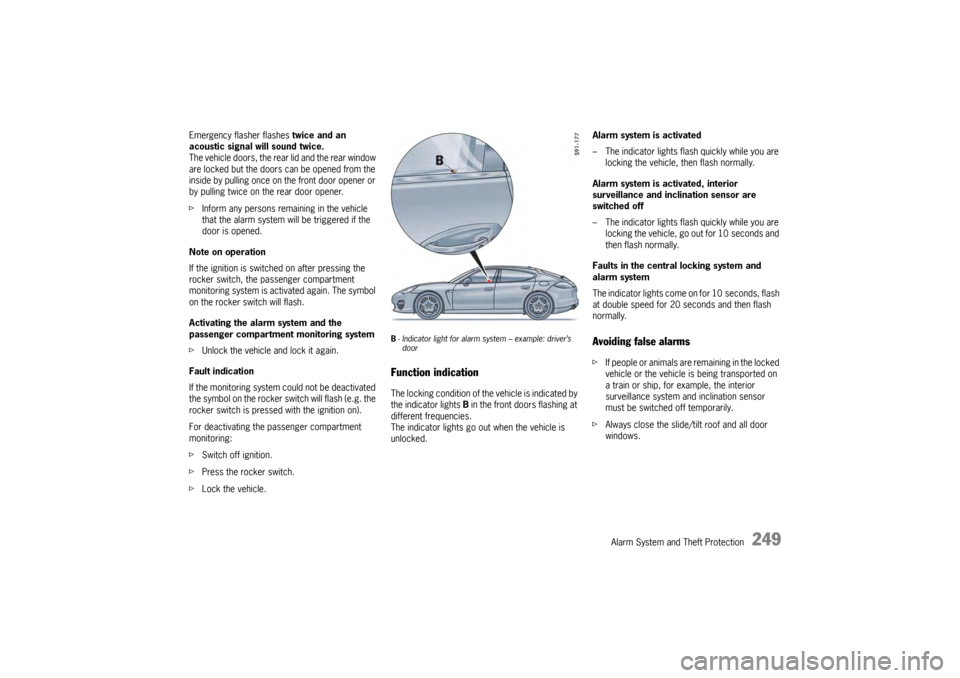
Alarm System and Theft Protection
249
Emergency flasher flashes twice and an
acoustic signal will sound twice.
The vehicle doors, the rear lid and the rear window
are locked but the doors can be opened from the
inside by pulling once on the front door opener or
by pulling twice on the rear door opener.
fInform any persons remaining in the vehicle
that the alarm system will be triggered if the
door is opened.
Note on operation
If the ignition is switched on after pressing the
rocker switch, the passenger compartment
monitoring system is activated again. The symbol
on the rocker switch will flash.
Activating the alarm system and the
passenger compartment monitoring system
f Unlock the vehicle and lock it again.
Fault indication
If the monitoring system could not be deactivated
the symbol on the rocker sw itch will flash (e.g. the
rocker switch is pressed with the ignition on).
For deactivating the passenger compartment
monitoring:
f Switch off ignition.
f Press the rocker switch.
f Lock the vehicle.
B- Indicator light for alarm system – example: driver’s
doorFunction indicationThe locking condition of the vehicle is indicated by
the indicator lights B in the front doors flashing at
different frequencies.
The indicator lights go out when the vehicle is
unlocked. Alarm system is activated
– The indicator lights flash quickly while you are
locking the vehicle, then flash normally.
Alarm system is activated, interior
surveillance and inclination sensor are
switched off
– The indicator lights flash quickly while you are locking the vehicle, go out for 10 seconds and
then flash normally.
Faults in the central locking system and
alarm system
The indicator lights come on for 10 seconds, flash
at double speed for 20 seconds and then flash
normally.
Avoiding false alarmsf If people or animals are remaining in the locked
vehicle or the vehicle is being transported on
a train or ship, for example, the interior
surveillance system an d inclination sensor
must be switched off temporarily.
f Always close the slide/tilt roof and all door
windows.
Page 252 of 343

250
Alarm System and Theft Protection
ImmobilizerThere is a transponder (an electronic component),
containing a stored code, in each key.
Before the ignition is switched on, the ignition lock
checks the code.
The immobiliser can be deactivated and
the engine started only using an authorised
ignition key.
Locking the Steering ColumnVehicles without Porsche Entry & Drive Unlocking the steering column automatically
f Insert the ignition key into the ignition lock.
Locking the steering column automatically
f Remove the ignition key.Vehicles with Porsche Entry & DriveUnlocking the steering column automatically
f Turn the control unit out of ignition lock
position 0 .
Locking the steering column automatically
f Open the driver’s door (with the ignition
switched off).
Locking the steering column manually
f Once the ignition is sw itched off, turn the
control unit to ignition lock position 3 again
and hold it there for 2seconds.
The steering column locks with an
audible click.
Theft ProtectionWhen leaving the vehicle, always:
f Close all door windows.
f Close the slide/tilt roof.
f Remove the ignition key (or switch ignition off
on vehicles with Porsche Entry & Drive).
f Lock the glove box.
f Close all storage compartments.
f Remove valuables, vehicle registration
documents, telephone and house keys from
the vehicle.
f Cover the luggage compartment with the
retractable luggage compartment cover.
f Close the tailgate.
f Lock all doors.
Page 253 of 343
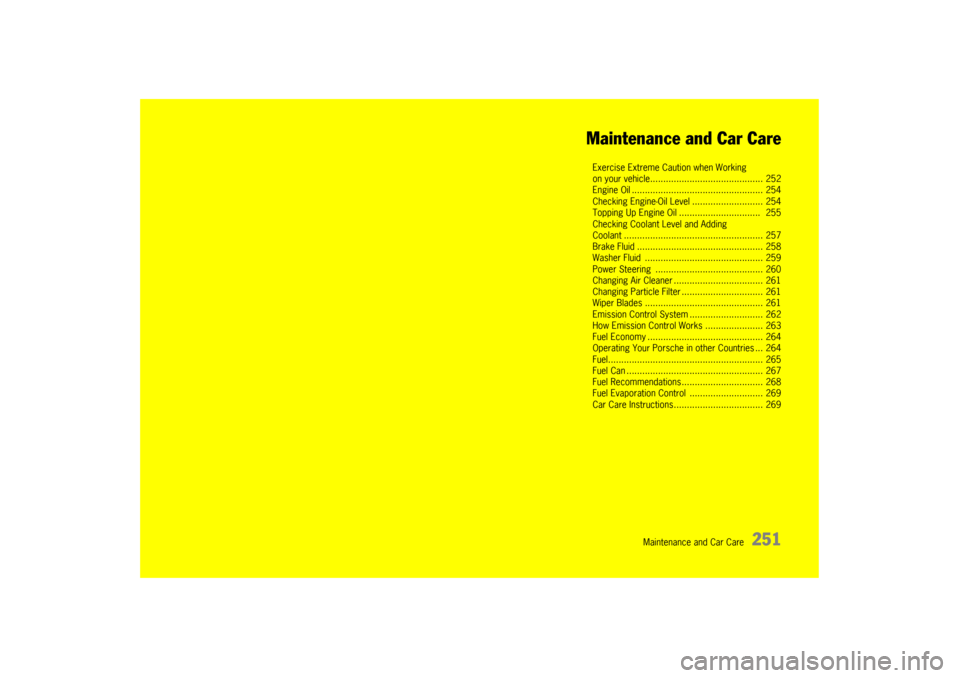
Maintenance and Car Care
251
Maintenance and Car Care
Exercise Extreme Caution when Working
on your vehicle........
................................... 252
Engine Oil ............... ................................... 254
Checking Engine-Oil Le vel ........................... 254
Topping Up Engine Oil . .............................. 255
Checking Coolant Level and Adding
Coolant ........................................... .......... 257
Brake Fluid .................. .............................. 258
Washer Fluid .......... ................................... 259
Power Steering ...... ................................... 260
Changing Air Cleaner .................................. 261
Changing Particle Filt er ............................... 261
Wiper Blades ............... .............................. 261
Emission Control Syst em ............................ 262
How Emission Control Works ...................... 263
Fuel Economy .............. .............................. 264
Operating Your Porsche in other Countries ... 264
Fuel............................. .............................. 265
Fuel Can ...................... .............................. 267
Fuel Recommendation s............................... 268
Fuel Evaporation Contr ol ............................ 269
Car Care Instructions .................................. 269
Page 254 of 343

252
Maintenance and Car Care
Exercise Extreme Caution when
Working on your vehicle
Danger!
Ignoring the following instructions may
cause serious personal injury or death.
f The engine compartment of any motor vehicle
is a potentially hazardou s area. If you are not
fully familiar with proper repair procedures, do
not attempt the adjustments described on the
following pages.
f O n l y w o r k o n y o u r v e h i c l e o u t d o o r s o r i n a w e l l
ventilated area.
f Ensure that there are no open flames in the
area of your vehicle at any time when fuel
fumes might be present. Be especially
cautious of devices such as hot water heaters
which ignite a flame intermittently.
f Before working on any part in the engine
compartment, turn the engine off and let it cool
down sufficiently. Hot engine compartment
components can burn skin on contact.
f Be alert and cautious around the engine at all
times while it is running. If you have to work on
the engine while it is running, always put the
parking brake on and put the PDK selector
lever in position P or N.
f In particular, be very careful to ensure that
items of clothing (ties, shirt, sleeves etc.),
jewelry, long hair, hand or fingers cannot get caught in the fan, belts or other moving parts.
The radiator and radiator fans are in the front
of the car.
The fans can start or continue running as a
function of temperature,
even with the engine
switched off.
Carry out work in these areas only with the
engine off and exercise extreme caution.
f Your Porsche is equipped with an electronic
ignition system. When the ignition is on, high
voltage is present in all wires connected with
the ignition system; therefore, exercise
extreme caution when working on any part of
the engine while the ignition is on or the engine
is running.
f Always support your car with safety stands if it
is necessary to work under the car. The jack
supplied with the car is not adequate for this
purpose.
Switch off level control of air suspension and
height adjustment.
Please see the chapter “RAISING THE VEHICLE
WITH A LIFTING PLATFORM, TROLLEY JACK
OR STANDARD JACK” on page 290.
f When working under the car without safety
stands but with the wheels on the ground,
make sure the car is on level ground, the
wheels are blocked, and that the engine
cannot be started.
Withdraw ignition keys (switch ignition off in
vehicles that have Porsche Entry & Drive). f
Do not smoke or allow an open flame around
the battery or fuel.
Keep a fire extinguisher close at hand.
f Incomplete or improper servicing may cause
problems in the operation of the car. If in doubt
about any servicing, have it done by your
authorized Porsche dealer.
Improper maintenance during the warranty
period may affect your Porsche warranty
coverage.
f Supplies of fluids, e.g. engine oil, washer fluid,
brake fluid or coolant, are hazardous to your
health.
Keep these fluids out of children's reach and
dispose of them in accordance with the
appropriate regulations.
f Some countries require additional tools and
special spare parts to be carried in your
vehicle. Please make enquiries before driving
abroad.
Page 255 of 343

Maintenance and Car Care
253
Technical ModificationsfModifications may be carried out on your
vehicle only if approved by Porsche.
This ensures that your Porsche will remain
reliable and safe to drive, and that it will not be
damaged as a result of the modifications.
Your authorized Porsche dealer will be pleased
to advise you.
Safety notes!
f Only use genuine Porsche spare parts for your
vehicle or spare parts of similar quality which
have been manufactured according to the
specifications and production requirements of
Porsche. These parts are available from your
authorized Porsche dealer or a qualified
specialist workshop. Safety-related
accessories should only be used if they are
from the Porsche Tequipment range or are
tested and approved by Porsche. Your
authorized Porsche dealer will be pleased to
advise you and answer any questions you may
have.
However, the use of other parts or
accessories may adversel y affect the safety
of your vehicle, and Porsche can take no
responsibility for any loss or damage caused
by their use.
Even if the supplier of other accessories or
parts is a recognized supplier, the safety of
your vehicle may still be affected if such items
are installed.
Due to the large variety of products offered in the accessory market, it is not possible for
Porsche to inspect and approve every one.
f In addition, please note that the use of
replacement parts that are not genuine
Porsche parts or approved parts, or the use of
accessories not approved by Porsche may
also detrimentally affect your vehicle warranty.
f Check your vehicle regularly for signs of
damage. Damaged or missing aerodynamic
components, such as spoilers or underbody
panels, impair vehicle handling and must
therefore be replaced immediately.
Radiator fanFor information on radiator fans:
fPlease see the chapter “RADIATOR FANS” on
page 258.
Warning!
Danger of injury. After the ignition is
switched off, the engine compartment and
coolant temperatures are monitored for
approx. 30 minutes. During this period, and
depending on temperature, the radiator fan
may continue to run or start to run.
f Carry out work in these areas only with the engine off and exercise extreme caution.
Measurements on test standsPerformance test
Performance tests on roller-type test stands are
not approved by Porsche.
Brake tests
Brake tests must be performed only on roller-type
test stands.
The following limit values must not be exceeded
on roller-type test stands:
– Test speed 4.7 mph (7.5 km/h)
– Test duration 20 seconds
Testing the electric parking brake
Electric parking brake tests on the brake test
stand must only be performed with the ignition
switched on and with the manual gearshift lever in
neutral or the Porsche Doppelkupplung selector
lever in position N.
The vehicle switches auto matically to brake test
stand mode, in which the electric parking brake
can be tested.
The message “Electric parking brake in service
mode” appears on the multi-function display in the
instrument panel.
Balancing wheels on the vehicle
During finish balancing of the wheels, the entire
vehicle must be lifted and the wheels must be free
to turn.
Page 256 of 343

254
Maintenance and Car Care
Engine OilIt is important to perform oil changes regularly in
accordance with the intervals specified in your
Maintenance Schedule.Engine oil consumptionIt is normal for your engine to consume oil.
The rate of oil consumption depends on the quality
and viscosity of oil, the speed at which the engine
is operated, the climate, road conditions as well
as the amount of dilution and oxidation of the
lubricant.
If the vehicle is used for repeated short trips, and
consumes a normal amount of oil, the engine oil
measurement may not show any drop in the oil
level at all, even afte r 600 miles (1000 km) or
more. This is because the oil is gradually
becoming diluted with fuel or moisture, making it
appear that the oil level has not changed.
The diluting ingredients evaporate out when the
vehicle is driven at high speeds, as on an
expressway, making it then appear that oil is
excessively consumed after driving at high
speeds.
If the conditions you drive your vehicle in are
dusty, humid, or hot, the frequency of the oil
change intervals should be greater. If the vehicle is driven at a high rate of speed,
climatic conditions are warm, and the load is high,
the oil should be checked more frequently, as
driving conditions will de
termine the rate of oil
consumption.
– The engine in your vehicle depends on oil to lubricate and cool all of its moving parts.
Therefore, the engine oil should be checked
regularly and kept at the required level.
– Make it a habit to have the engine oil level checked with every refueling.
– The oil pressure warning light is not an oil level indicator.
The oil pressure warning light indicates serious
engine damage may be occuring when lit, if
engine rpm is above idle speed.
Checking Engine-Oil Levelf Check the oil level on the multi-function display
at regular intervals before refuelling.
f Please see the chapter “OIL LEVEL DISPLAY
AND MEASUREMENT OF THE ENGINE OIL
LEVEL” on page 121.
Warning!
Engine oil is hazardous to your health and
may be fatal if swallowed.
f Keep engine oil out of children's reach.
Used engine oil contains chemicals that have
caused cancer in laboratory animals.
f Always protect your skin by washing thoroughly with soap and water.
Top-up quantity
The difference between the minimum and
maximum marks on the segment display is
approx. 1.06 US quearts (1 liter).
One segment of the display corresponds to
a top-up quantity of approx. 0.26 US quarts
(0.25 liters).
f Never add more engine oil than required to
reach the maximum mark.
Page 257 of 343

Maintenance and Car Care
255
If the oil level is too low, this is indicated by the
oil-warning light on the multi-function display.
f Correct the oil level as soon as possible.
f Please see the chapter “OVERVIEW OF
WARNING MESSAGES” on page 152.
Note on operation
If the engine compartment lid is opened and no
oil is added, the warning message appears again
after at least 6 miles (10 km).
Warning!
Risk of injury. The radiator fans can start
running when a certain temperature is
reached, even with the engine switched off.
Risk of burns from hot parts in the engine
compartment.
f Exercise extreme caution when working in the engine compartment.
Topping Up Engine OilPorsche recommends .1) Generally, you can find details on the
manufacturer approvals on the oil containers or as
a notice displayed by the retailer.
The current approval status is also available from
your authorized Porsche dealer.2) SAE viscosity class - Example: SAE 0W - 40
Specification 0W = Viscos ity specification for low
temperatures (winter).
Specification 40 = Viscosity specification for high
temperatures.3) For all temperature ranges.4) For the temperature range over –13 °F
(–25 °C).
Always observe the following points:
– Use engine oils approved by Porsche only. This is a precondition for optimum and
problem-free driving.
– Regular oil changes are part of servicing. It is important that the service intervals,
particularly the oil change intervals, are
observed in accordance with the specifications
in the “Maintenance” booklet. – Oils approved by Pors
che can be mixed with
each other.
– Porsche engines are designed so that no oil additives may be used.
– A label is located in the engine compartment,
which provides you with information on suitable
oil for your engine.
Your authorized Porsche dealer will be pleased to
advise you.
Caution!
Fire hazard if engine oil comes into contact
with hot engine parts.
Risk of damage if engine oil comes into
contact with the drive belt.
f Exercise extreme caution when topping up
engine oil.
f Top up engine oil only with the engine stopped and ignition switched off.
f Please see the chapter “EXERCISE EXTREME
CAUTION WHEN WORKING ON YOUR VEHICLE”
on page 252.
Oil-level warning
Complies with
approval
1)
Viscosity class
2)
Porsche A40 SAE 0W - 40
3)
SAE 5W - 40
4)
SAE 5W - 50
4)
Page 258 of 343
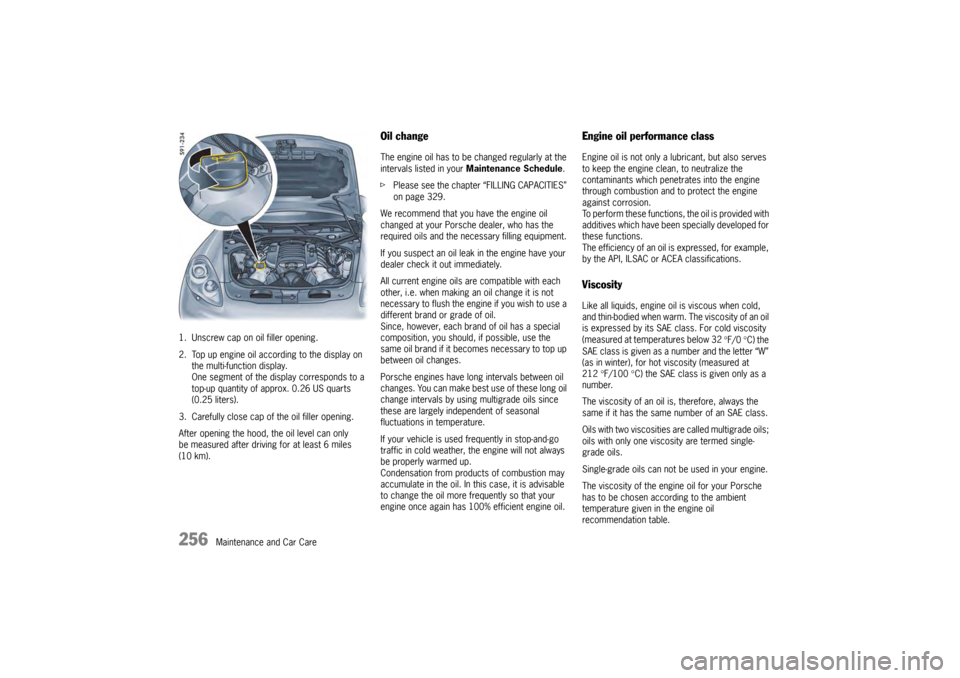
256
Maintenance and Car Care
1. Unscrew cap on oil filler opening.
2. Top up engine oil according to the display on
the multi-function display.
One segment of the display corresponds to a
top-up quantity of approx. 0.26 US quarts
(0.25 liters).
3. Carefully close cap of the oil filler opening.
After opening the hood, the oil level can only
be measured after driving for at least 6 miles
(10 km).
Oil changeThe engine oil has to be changed regularly at the
intervals listed in your Maintenance Schedule .
f Please see the chapter “FILLING CAPACITIES”
on page 329.
We recommend that you have the engine oil
changed at your Porsche dealer, who has the
required oils and the necessary filling equipment.
If you suspect an oil leak in the engine have your
dealer check it out immediately.
All current engine oils are compatible with each
other, i.e. when making an oil change it is not
necessary to flush the engi ne if you wish to use a
different brand or grade of oil.
Since, however, each brand of oil has a special
composition, you should, if possible, use the
same oil brand if it beco mes necessary to top up
between oil changes.
Porsche engines have long intervals between oil
changes. You can make best use of these long oil
change intervals by usin g multigrade oils since
these are largely independent of seasonal
fluctuations in temperature.
If your vehicle is used frequently in stop-and-go
traffic in cold weather, the engine will not always
be properly warmed up.
Condensation from products of combustion may
accumulate in the oil. In this case, it is advisable
to change the oil more frequently so that your
engine once again has 100% efficient engine oil.
Engine oil performance class Engine oil is not only a lubricant, but also serves
to keep the engine clean, to neutralize the
contaminants which penetrates into the engine
through combustion and to protect the engine
against corrosion.
To perform these functions, the oil is provided with
additives which have been specially developed for
these functions.
The efficiency of an oil is expressed, for example,
by the API, ILSAC or ACEA classifications. Viscosity Like all liquids, engine oil is viscous when cold,
and thin-bodied when warm. The viscosity of an oil
is expressed by its SAE class. For cold viscosity
(measured at temperatures below 32 °
F/0 °
C) the
SAE class is given as a number and the letter “W”
(as in winter), for hot viscosity (measured at
212 °
F/100 °
C) the SAE class is given only as a
number.
The viscosity of an oil is, therefore, always the
same if it has the same number of an SAE class.
Oils with two viscosities are called multigrade oils;
oils with only one viscosity are termed single-
grade oils.
Single-grade oils can not be used in your engine.
The viscosity of the engine oil for your Porsche
has to be chosen according to the ambient
temperature given in the engine oil
recommendation table.
Page 259 of 343
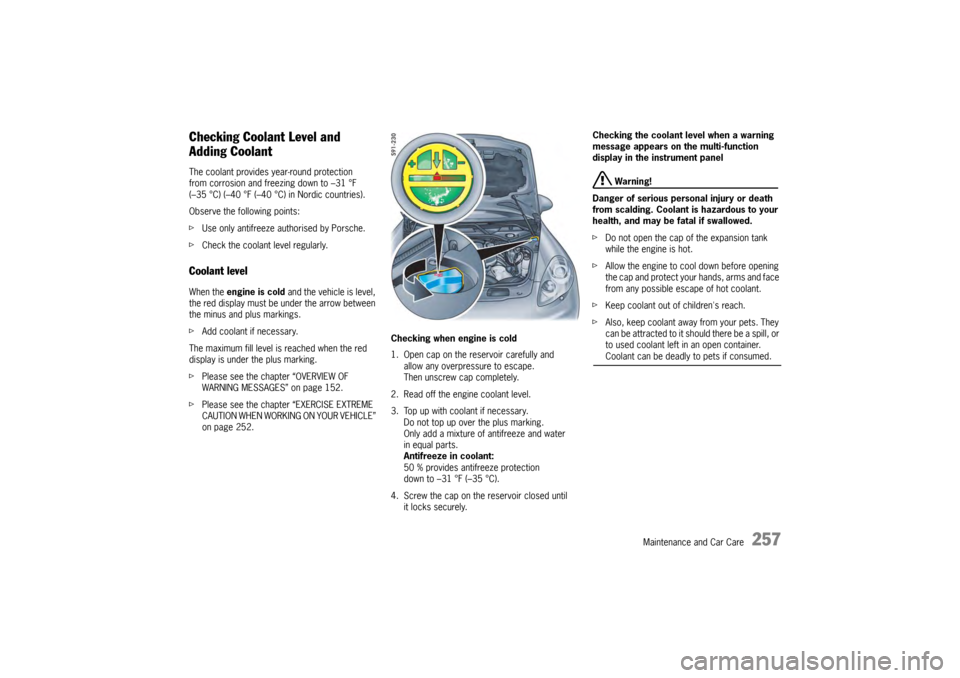
Maintenance and Car Care
257
Checking Coolant Level and
Adding CoolantThe coolant provides year-round protection
from corrosion and freezing down to –31 °F
(–35 °C) (–40 °F (–40 °C) in Nordic countries).
Observe the following points:
fUse only antifreeze authorised by Porsche.
f Check the coolant level regularly.Coolant levelWhen the engine is cold and the vehicle is level,
the red display must be under the arrow between
the minus and plus markings.
f Add coolant if necessary.
The maximum fill level is reached when the red
display is under the plus marking.
f Please see the chapter “OVERVIEW OF
WARNING MESSAGES” on page 152.
f Please see the chapter “EXERCISE EXTREME
CAUTION WHEN WORKING ON YOUR VEHICLE”
on page 252. Checking when engine is cold
1. Open cap on the reservoir carefully and
allow any overpressure to escape.
Then unscrew cap completely.
2. Read off the engine coolant level.
3. Top up with coolant if necessary. Do not top up over the plus marking.
Only add a mixture of antifreeze and water
in equal parts.
Antifreeze in coolant:
50 % provides antifreeze protection
down to –31 °F (–35 °C).
4. Screw the cap on the reservoir closed until it locks securely. Checking the coolant level when a warning
message appears on the multi-function
display in the instrument panel
Warning!
Danger of serious personal injury or death
from scalding. Coolant is hazardous to your
health, and may be fatal if swallowed.
f Do not open the cap of the expansion tank
while the engine is hot.
f Allow the engine to cool down before opening
the cap and protect your hands, arms and face
from any possible escape of hot coolant.
f Keep coolant out of children's reach.
f Also, keep coolant away from your pets. They
can be attracted to it should there be a spill, or
to used coolant left in an open container. Coolant can be deadly to pets if consumed.
Page 260 of 343
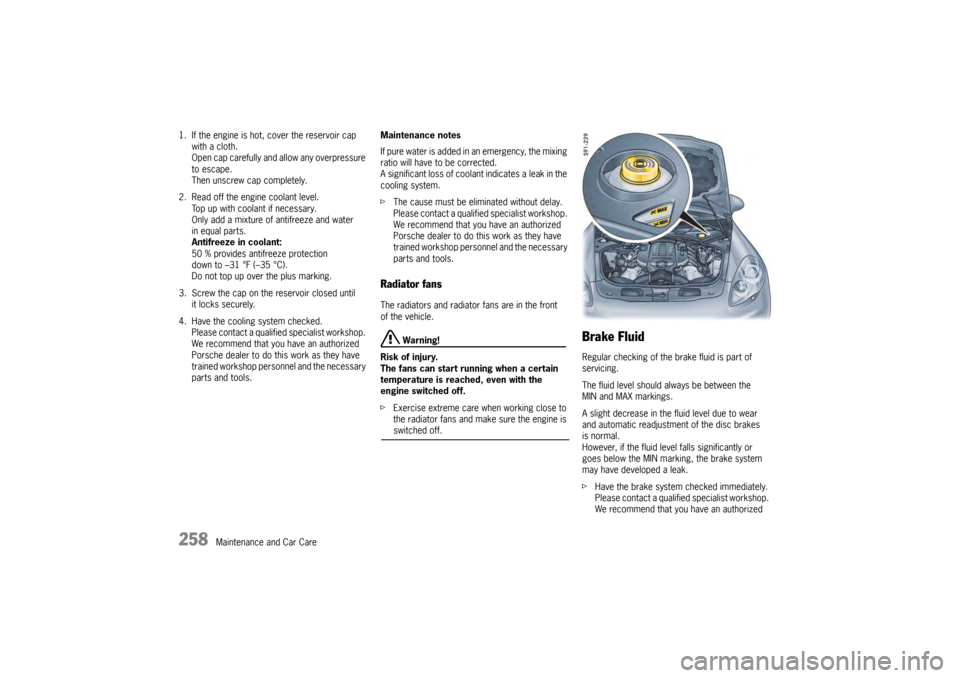
258
Maintenance and Car Care
1. If the engine is hot, cover the reservoir cap
with a cloth.
Open cap carefully and allow any overpressure
to escape.
Then unscrew cap completely.
2. Read off the engine coolant level. Top up with coolant if necessary.
Only add a mixture of antifreeze and water
in equal parts.
Antifreeze in coolant:
50 % provides antifreeze protection
down to –31 °F (–35 °C).
Do not top up over the plus marking.
3. Screw the cap on the reservoir closed until it locks securely.
4. Have the cooling system checked. Please contact a qualif ied specialist workshop.
We recommend that you have an authorized
Porsche dealer to do this work as they have
trained workshop personnel and the necessary
parts and tools. Maintenance notes
If pure water is added in an emergency, the mixing
ratio will have to be corrected.
A significant loss of coolan
t indicates a leak in the
cooling system.
f The cause must be eliminated without delay.
Please contact a qualified specialist workshop.
We recommend that you have an authorized
Porsche dealer to do this work as they have
trained workshop personnel and the necessary
parts and tools.
Radiator fansThe radiators and radiator fans are in the front
of the vehicle.
Warning!
Risk of injury.
The fans can start running when a certain
temperature is reached, even with the
engine switched off.
f Exercise extreme care when working close to
the radiator fans and make sure the engine is switched off.
Brake FluidRegular checking of the brake fluid is part of
servicing.
The fluid level should always be between the
MIN and MAX markings.
A slight decrease in the fluid level due to wear
and automatic readjustment of the disc brakes
is normal.
However, if the fluid level falls significantly or
goes below the MIN marking, the brake system
may have developed a leak.
fHave the brake system checked immediately.
Please contact a qualified specialist workshop.
We recommend that you have an authorized